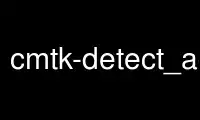
This is the command cmtk-detect_adni_phantom that can be run in the OnWorks free hosting provider using one of our multiple free online workstations such as Ubuntu Online, Fedora Online, Windows online emulator or MAC OS online emulator
PROGRAM:
NAME
detect_adni_phantom - Detect ADNI phantom landmarks in phantom image
SYNOPSIS
detect_adni_phantom InputImage OutputXML
DESCRIPTION
This tool detects the locations of all spherical landmarks in a 3D image of the Magphan
EMR051 structural imaging phantom (a.k.a. ADNI Phantom).
OPTIONS
Global Toolkit Options (these are shared by all CMTK tools)
--help
Write list of basic command line options to standard output.
--help-all
Write complete list of basic and advanced command line options to standard output.
--wiki
Write list of command line options to standard output in MediaWiki markup.
--man
Write man page source in 'nroff' markup to standard output.
--version
Write toolkit version to standard output.
--echo
Write the current command line to standard output.
--verbose-level <integer>
Set verbosity level.
--verbose, -v
Increment verbosity level by 1 (deprecated; supported for backward compatibility).
--threads <integer>
Set maximum number of parallel threads (for POSIX threads and OpenMP).
Phantom Detection Options
--tolerant
Be tolerant of issues such as partially truncated marker spheres. This should be used
with caution only when necessary, and both the phantom image and detection results
should be carefully inspected to identify the source of detection problems and verify
reliable results.
--any-orientation
Do not assume standard orientation of the phantom, i.e., allow phantoms scanned
upside-down. This makes detection of defective phantoms less robust.
--fallback-cnr-centroid
Force a fallback to use centroid of CNR spheres rather than center of SNR sphere for
initial orientation. This can be used when, for example, the SNR sphere has broken
off but is positioned in a way that does not trigger the automatic fallback.
--erode-snr <double>
Erode SNR sphere by this distance prior to computing SNR estimate. [Default: 10]
--erode-cnr <double>
Erode each CNR sphere by this distance prior to computing CNR estimate. [Default: 5]
--refine-xform
Refine estimated affine transformation after each new landmark is added.
--refine-outliers
Refine outlier landmarks based on estimated transformation after first sphere
detection pass.
--exclude-outliers
Exclude outlier landmarks before fitting final transformations.
--no-bias-correct-spheres
Disable intensity bias field correction for each detected sphere. This will likely
reduce accuracy of SNR/CNR estimates and also affect localication accuracy of smaller
spheres, but may be helpful in extreme cases where bias correction fails completely.
Output Options
--write-labels <image-path>
Output label image path. This image contains the mask of detected spheres, each
labeled uniquely in their order in CMTK's ADNI phantom fiducial table. [Default:
NONE]
--write-rigid <transformation-path>
Output path for the fitted rigid transformation from phantom space into RAS image
standard space. This transformation defines where each sphere should be in the image.
[Default: NONE]
--write-affine <transformation-path>
Output path for the fitted affine transformation from phantom space into RAS image
standard space. This is the closest linear-fit transformation, and as such it
includes scale and shear components not present in the fitted rigid transformations.
Since these components are due to scanner miscalibration and distortion, this
transformation DOES NOT specify the correct spehre locations in the image, but
rather, allows for quantification of scale miscalibration. [Default: NONE]
AUTHORS
Torsten Rohlfing, with contributions from Michael P. Hasak, Greg Jefferis, Calvin R.
Maurer, Daniel B. Russakoff, and Yaroslav Halchenko
Use cmtk-detect_adni_phantom online using onworks.net services
